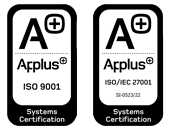What are the differences between QR codes and NFC technology?
We hear more and more about NFC technology and QR codes. This can be because of the boom of mobile payments, but this is only its best-known use. Keep reading because in this post we are going to explain how you can use this type of contactless technology and what the differences between NFC technology and QR codes are.
Since the beginning of the 2000s, more and more technologies have been developed in order to be a complement of mobile devices. From Bluetooth, NFC technology, WiFi, or QR codes.
It should be noted that these technologies have not emerged as substitutes for each other but as complementary tools. Therefore, it is not possible to say which is better or worse, but it depends on the use that is going to be given and what the objectives are.
In this post, we are going to show you the main differences between NFC technology and QR codes and their utilities. Let’s start!
What is NFC? What are its uses?
According to its acronym in English, NFC means Near Field Communication. This technology is a simple, fast, and secure short-range wireless communication system between devices where the distance cannot be greater than 10 or 20 cm. With it, you can make contactless transactions, share digital content or connect devices.
To use it, you have to bring the device reader closer to a tag or another reader. In this way, the device can read the stored information and thus do the action recorded on it.
If you want to know more about NFC, at ABAMobile we are specialized in this contactless technology.
Although the best-known use is to do mobile payments, NFC technology offers other utilities. For example, pairing devices, sharing information or controlling access to a venue.
All this is achieved thanks to record any action on an NFC tag and bring a device closer to it. With this, it is possible to show all the potential that this technology has.
How much does it cost to develop an app for your business? Find out now!
What are QR codes and for what we use them?
We have already explained what NFC technology is and some of its most common uses. But, before knowing the differences between NFC and QR codes, we will explain what QR codes are.
Another type of contactless technology is QR codes which means Quick Response Codes. These are kinds of barcodes that are read through the camera of mobile devices.
It is a fast, safe, and simple-to-use technology. Today, there are online platforms that make the generation of one of these codes easier without the need for complex settings or deep knowledge of technology.
A URL, a file, or multimedia content is usually entered so that users access that information and thus make a better user experience. Like NFC technology, QR codes are also used for mobile payments.

How can you read a QR code?
These codes are increasingly in our day-to-day. We can find them in newspapers, magazines, stores, or digital content. In addition, they are characterized by not being able to be readable to the human eye but can be read through the camera of smartphones.
There are two main options for reading QR codes:
On the one hand, if your smartphone is modern enough, simply by focusing the QR code with the camera, you are going to be able to access the content. On the other hand, you have another option if this does not work for you. There are a lot of QR reader apps that you can download so that QR codes can be read.
Over the last few years, QR codes have been increasingly implemented in more sectors and businesses. From IT companies, software developers to advertising and marketing strategies. These codes are a different way of sharing information. In addition, they involve users and the personalization of a service or product.
Differences between NFC and QR codes, which one works better?
Both NFC technology and QR Codes are contactless technology that has been around for a few years now. Thanks to smartphones and mobile payments, this technology has become known that we use it in many situations even without realizing it, such as when entering public transport with our transport pass.
Despite being similar technologies in some aspects, below we will tell you what the main differences between NFC and QR codes are.
Remember that, as we said at the beginning of this post, there is no better or worse, but they are used in different cases depending on the objectives and circumstances.
Differences between NFC technology and QR codes
NFC is more intuitive and easy-to-use than QR codes. With the first one, it is only necessary to have this technology activated and bring a device closer to a reader device. However, with QR codes it is necessary to open the camera to read the content.
It should also be taken into account that reading is slower using QR codes since the camera needs to focus on the code and read it correctly, while with NFC technology the reading is faster.
QR codes are simpler and cheaper to implement than NFC technology and its labels. Today, there are online platforms that facilitate the creation of QR codes and it would only be necessary to print them later so that they can be used.
For using NFC, it is necessary that devices have this technology. Otherwise, it cannot be used. Although more and more smartphones have NFC, it is not yet widespread. On the contrary, to read the QR codes you only need the mobile camera or a QR reading app.
Conclusions
Taking all this into account, choosing one or another technology is in your hand. You have to see the pros and cons. As we have said before, there is no better or worse technology but they work differently and each one has its advantages.
Both are tools that, although in Spain they still do not have a great force, in other areas of the world such as some Asian countries they already have NFC and QR codes in their day-to-day for years. In Spain and Europe, there is still much potential to be exploited both from NFC technology and from QR codes.
Get in touch with our team if you want to start a new project. Have an idea in mind?







